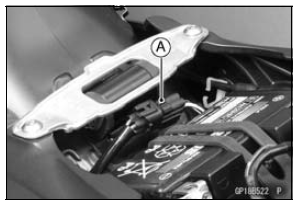


Connections: Battery (+) → 12 V 3.4 W Bulb (One Side) 12 V 3.4 W Bulb (Other Side) → R/BK lead [D] Battery (–) → BK/W lead [E]
If the test light turn on, the reserve switch is defective.
Replace the fuel pump.

Connections: Battery (+) → 12 V 3.4 W Bulb (One Side) 12 V 3.4 W Bulb (Other Side) → R/BK lead Battery (–) → BK/W lead
If the test light does not light, replace the fuel pump.
NOTE
It may take a long time to turn on the test light in case that the fuel reserve switch is inspected just after the fuel is drawn. Leave the fuel pump lead connector with leads for inspection connected for few minutes.
 Water Temperature Sensor Inspection
Water Temperature Sensor Inspection Oxygen Sensor Removal (Equipped Models)
Oxygen Sensor Removal (Equipped Models)Swingarm Bearing Removal
Remove:
Swingarm (see Swingarm Removal)
Collar [A]
Oil Seals [B]
Sleeve [C]
Circlip [D] (Right Side)
Special Tool - Inside Circlip Pliers: 57001-143
Remove the ball bearing and needle bearings.
Special Tool - Oil Seal & Bearing Remover [A]: 57001-1058
...
Water Temperature Sensor Output Voltage Inspection
NOTE
Be sure the battery is fully charged.
Turn the ignition switch to OFF.
Remove the throttle body assy (see Throttle Body Assy
Removal in the Fuel System (DFI) chapter).
Disconnect the water temperature sensor connector and
connect the measuring adapter [A] between these connectors
...
Fuel Pump Operating Voltage Inspection
NOTE
Be sure the battery is fully charged.
Turn the ignition switch to OFF.
Remove:
Fuel Tank Bolts (see Fuel Tank Removal)
Fuel Tank Bracket Bolts (see Fuel Tank Removal)
Disconnect the fuel pump lead connector and connect the
harness adapter [A] between these connectors as shown
i ...